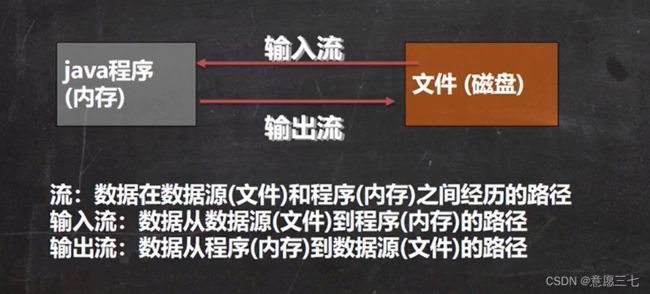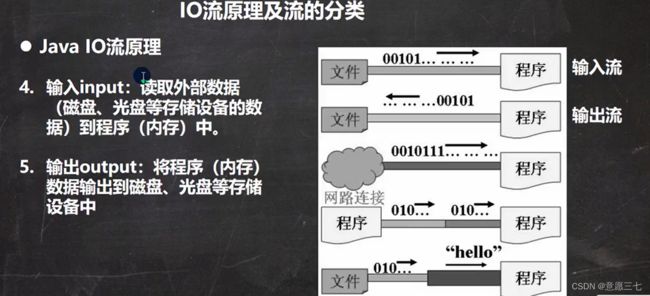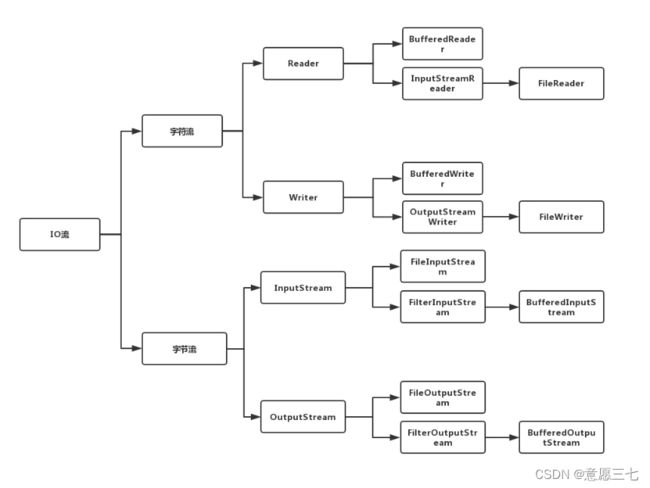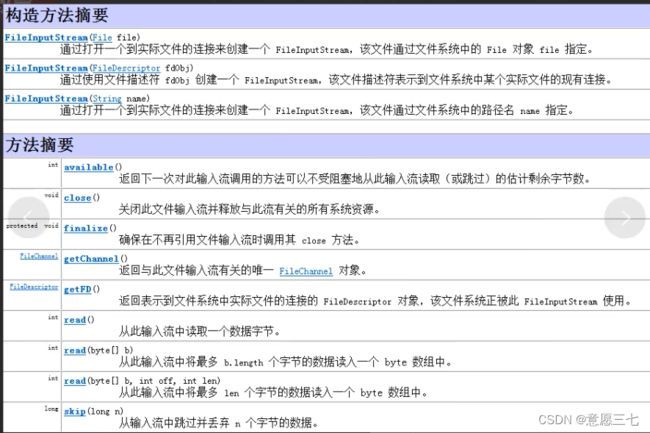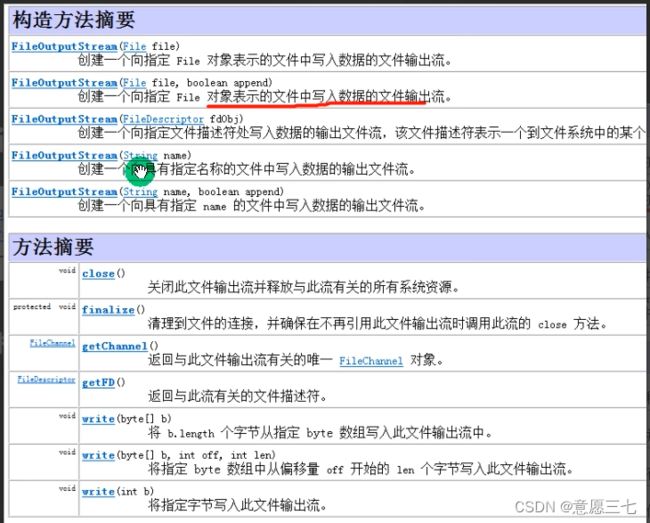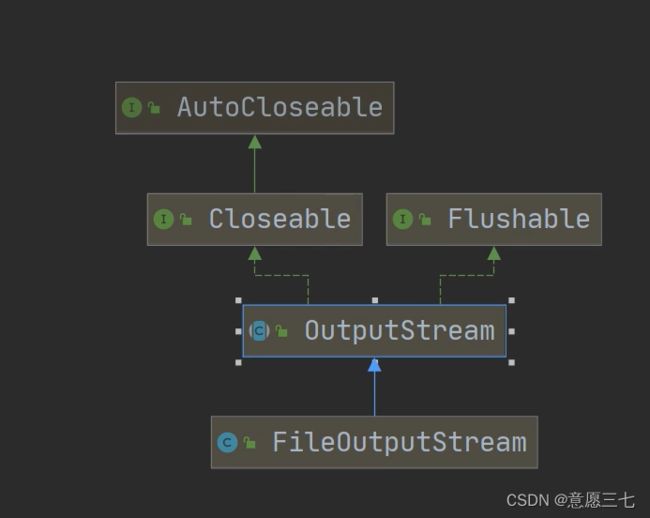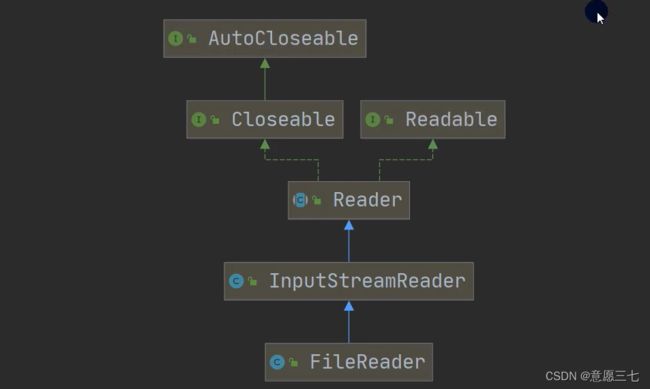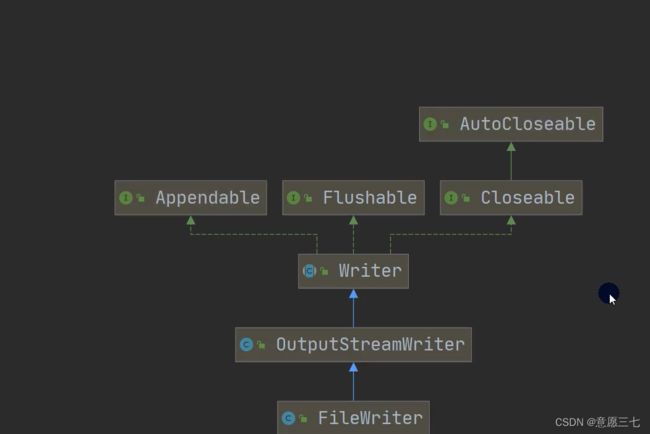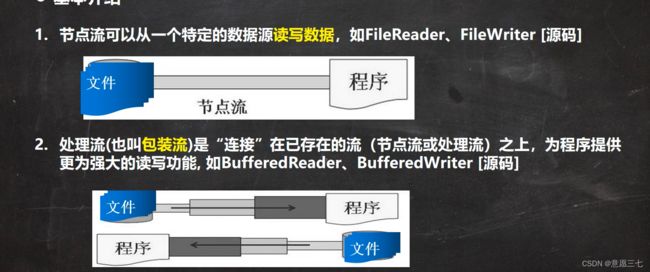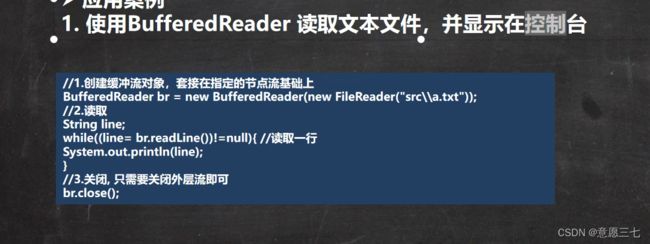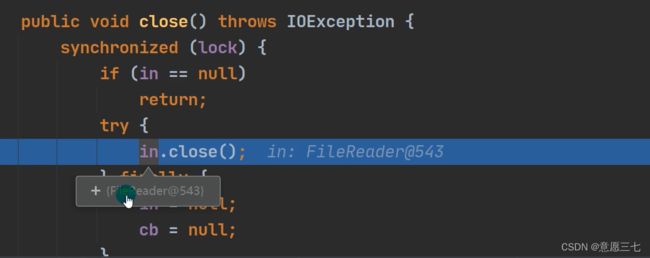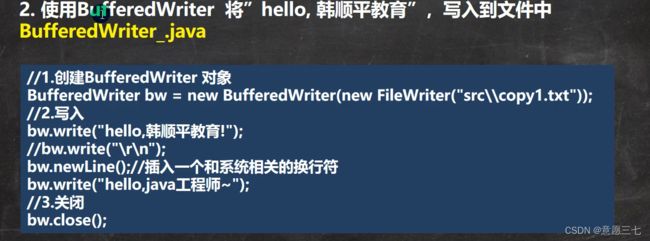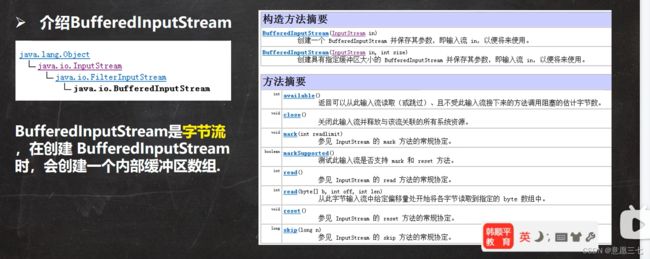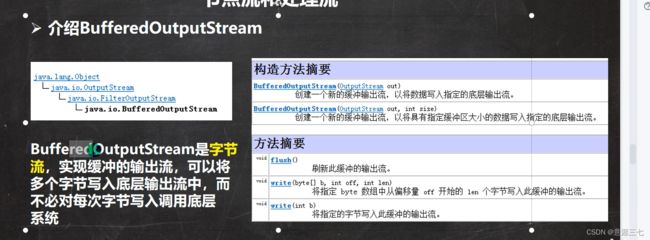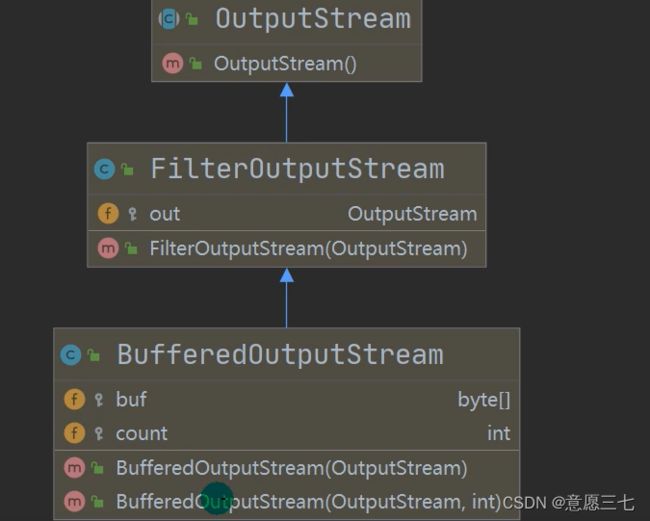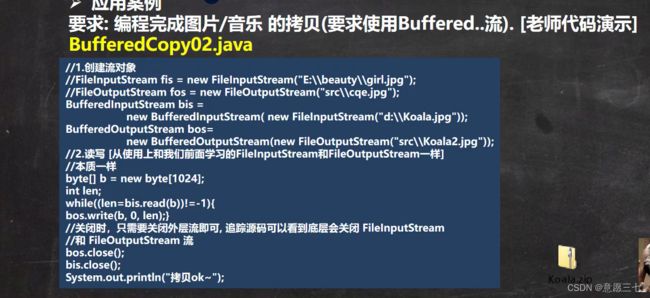【Java】一文认识IO操作流
快速上手IO流
- 一、什么是文件?
- 二、什么是文件流
- 三、常用的文件操作
-
- 1.创建文件
- 2.获取文件的相关信息
- 3.目录的创建和文件删除
- 四、IO流原理及流的分类
-
- 1.流的分类和原理:
- 2.常用的类
-
- 2.1 字节流的常用流
-
- 2.1.1 FileInputStream常用类
- 2.1.2 FileOutputStream常用类
- 2.1.3 使用字节输入输入出流拷贝一个文件
- 2.2 字符流的常用流
-
- 2.2.1 FileReader常用类
- 2.2.2 FileWriter常用类
- 3.节点流,处理流
-
- 3.1节点流和处理流的区别和联系
- 3.2 处理流-BufferedReader 和 BufferedWriter
-
- 3.2.2 BufferedReader
- 3.2.3 BufferedWriter
- 3.2.4BufferedReader 和 BufferedWriter 完成文本拷贝
- 3.3 处理流-BufferedInputStream 和 BufferedOutputStream
-
- 3.3.4 使用BufferedInputStream 和 BufferedOutputStream拷贝文件
一、什么是文件?
这个我想大家都知道,ppt啊,world文件,都是文件
二、什么是文件流
文件是在程序中已流的形式来操作的
水到胃就是输入流,往肚子里面输,
胃到水就是输出流,往肚子外吐。
三、常用的文件操作
1.创建文件
public static void main(String[] args) throws IOException {
//方式1
String filePath = "e:\\news1.txt"; //声明存放的地方,和文件名
File file = new File(filePath); //把信息放出来
file.createNewFile(); //创建文件
System.out.println("创建成功");
}
方式二 (根据父目录(就是存放路径)+子路径(就是文件名))
public static void main(String[] args) throws IOException {
File filePath = new File("E:\\test"); //存放路径
String fileName = "news2.txt"; //文件名称
File file = new File(filePath,fileName);
file.createNewFile();
System.out.println("创建成功");
}
其实在计算机,如果有File对象,只是在内存中有这么一个对象,但是在硬盘里面还没有,我们需要createNewFile()这个操作,把这个对象放进去硬盘。
相当于:孩子妈肚子里有孩子,但是没有出来,需要createNewFile(),才可以出来。
方式三
public static void main(String[] args) throws IOException {
String filePath = "E:\\test"; //存放路径
String fileName = "news3.txt"; //文件名称
File file = new File(filePath,fileName);
file.createNewFile();
System.out.println("创建成功");
}
也是上面差不多,只不过上面的是File 对象,加String
这个是2个String
2.获取文件的相关信息
public static void main(String[] args) {
String filePath = "e:\\news1.txt";
File file = new File(filePath);
System.out.println("得到文件名"+file.getName());
System.out.println("得到文件绝对路径"+file.getAbsolutePath());
System.out.println("得到文件父级目录"+file.getParent());
System.out.println("得到文件大小(按字节)"+file.length()); //utf-8 一个英文1个字节1个汉字3个字节
System.out.println("文件是否存在"+file.exists());
System.out.println("是不是一个文件"+file.isFile());
System.out.println("是不是一个目录"+file.isDirectory());
}
3.目录的创建和文件删除
判断e:\news1.txt文件是否存在,存在就删除
delete方法返回的是布尔值
public static void m1(){
String filePath = "e:\\news1.txt";
File file = new File(filePath);
if (file.exists()){
if (file.delete()){
System.out.println("删除成功");
}else{
System.out.println("删除失败");
}
}else{
System.out.println("文件不存在");
}
}
需要注意java中目录也是一个特殊的文件 也可以进行操作
public static void m2(){
String filePath = "E:\\del"; //这里是目录
File file = new File(filePath);
if (file.exists()){
if (file.delete()){
System.out.println("删除成功");
}else{
System.out.println("删除失败");
}
}else{
System.out.println("目录不存在");
}
}
需注意:目录里面有文件 delete删除不了
判断目录是否存在,没有就创建
需注意mkdirs()是创建多级目录,创建一级目录(就是一个文件夹)使用mkdir(),不正确使用会报错
public static void m3(){
String DirectoryPath = "E:\\del\\a\\b\\c";
File file = new File(DirectoryPath);
if (file.exists()){
System.out.println("目录存在");
}else{
if (file.mkdirs()){
System.out.println("该目录创建成功");
}else{
System.out.println("创建失败");
}
}
}
四、IO流原理及流的分类
1.流的分类和原理:
1)按照数据单位不同分为:
字节流(8 bit),字符流
注意字符流并不可以确定是多大单位,因为是要看编码格式的,
它们的效率谁好,那肯定字符流,因为字节流读取单位小,
应用场景:
那为什么要字节流,字节流可以操作二进制文件,比如音乐,视频,可以进行无损操作。
字符流用来操作文本文件这样的比较好。
2)按照数据流的流向分为:
输入流
输出流
3)按照流的角色不同分为:
节点流,处理流/包装流
字节流和字符流 分别对应两种流

字节流的两大类:字节输入流,字节输出流
它们2个的顶级父类,分别是InputSream 和OutputStream 都是抽象类
使用的时候要实现它们的子类才可以
字符流的两大类:字符输入流,字符输出流
它们2个的顶级父类,分别是Reader 和Writer 都是抽象类
使用的时候要实现它们的子类才可以
Java的IO有40多个类,实际上非常规则,都是从上面4个抽象类派生出来的
由这四个类派生出来的子类名称都是以其父类名当子类名后缀。
我们通过画图来看清楚流到底是什么:
反之一样
2.常用的类
2.1 字节流的常用流
- FileInputStream:文件输入流
- BufferedInputStream:缓冲字节输入流
- ObjectInputStream:对象字节输入流
来看看关系,发现BufferedInputStream的父类其实是FilterInputStream,但是这个父类也是InputStream的子类

2.1.1 FileInputStream常用类
那些参数是什么意思呢,其实我们看第一个就比较形象了,File对象是个文件(这里当物品/东西),FileInputStream 是外卖小哥,小哥拿着物品去送出去,物品和小哥之间有一定的联系。
使用read()无参数构造方法,读取完毕返回-1
public static void readFile01(){
String filepath = "E:\\test\\hello.txt";
FileInputStream fileInputStream = null; //如果定义在try里面 finally使用不了
int readDate = 0;
try {
//创建FileInputStream对象用于读取文件
fileInputStream = new FileInputStream(filepath);
//read() 返回-1代表读取完毕
while((readDate = fileInputStream.read()) != -1){ //为什么要循环因为读取的内容可能不是一次
System.out.print((char)readDate);
}
} catch (IOException e) {
e.printStackTrace();
}finally {
//关闭流 流是一种资源,不关闭会造成浪费
try {
fileInputStream.close();
} catch (IOException e) {
e.printStackTrace();
}
}
}
使用read无参构造方法,其实还是有不好的单个效率太低,我们可以使用read的其他构造参数。
使用read()字符数组构造方法,读取完毕返回-1,未结束反复字符数组的长度,
public static void readFile02(){
//字节数组
byte[] buf = new byte[8];//一次读8个字节
int readDate = 0; //接收字符的长度
String filepath = "E:\\test\\hello.txt";
FileInputStream fileInputStream = null; //如果定义在try里面 finally使用不了
try {
//创建FileInputStream对象用于读取文件
fileInputStream = new FileInputStream(filepath);
//read() 返回-1代表读取完毕
while((readDate = fileInputStream.read(buf)) != -1){ //为什么要循环因为读取的内容可能不是一次
System.out.print(new String(buf,0,readDate));//
}
} catch (IOException e) {
e.printStackTrace();
}finally {
//关闭流 流是一种资源,不关闭会造成浪费
try {
fileInputStream.close();
} catch (IOException e) {
e.printStackTrace();
}
}
}
2.1.2 FileOutputStream常用类
public static void writerFile(){
//创建一个FileOutPutStream
String filePath = "E:\\test\\a.txt";
FileOutputStream fileOutputStream = null;
try {
//得到FileOutputStream对象
fileOutputStream = new FileOutputStream(filePath);
//写入一个字节
//fileOutputStream.write('a');
//写入一个字符串
String str = "hello,world";
fileOutputStream.write(str.getBytes());
// String的方法,把字符串转为字符数组,write() 会覆盖
System.out.println("写入成功");
} catch (IOException e) {
e.printStackTrace();
}finally {
try {
fileOutputStream.close();
} catch (IOException e) {
e.printStackTrace();
}
}
}
Write ()会覆盖,如果不想覆盖就,第二个参数变成true,追加到文字后。
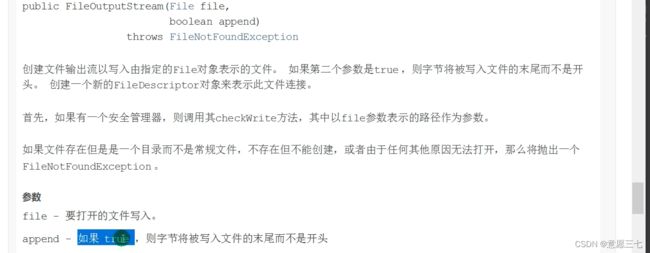
2.1.3 使用字节输入输入出流拷贝一个文件
public static void main(String[] args) {
//src 原目标文件 dest 拷贝到什么位置
String srcfilePath = "C:\\Users\\Administrator\\Pictures\\Saved Pictures\\QQ图片20210806104237.jpg";
String destfilePath = "D:\\A1\\QQ.jpg";
FileInputStream fileInputStream = null;
FileOutputStream fileOutputStream = null;
try {
fileInputStream = new FileInputStream(srcfilePath); //先图片输入到程序
fileOutputStream = new FileOutputStream(destfilePath); //在从程序输出到文件夹
//定义字节数组提高效率
byte [] buf = new byte[1024];
int readLen = 0;
while ((readLen = fileInputStream.read(buf))!= -1){
//读取到程序就由程序写出去 通过fileOutputStream
//边读边写
fileOutputStream.write(buf,0,readLen);
//一定使用这个方法 带这些参数 为什么呢?因为怕其他的冗余数据进去 破坏文件 1039个字节,一次1024 还有剩余可能会有问题
}
System.out.println("拷贝OK");
} catch (IOException e) {
e.printStackTrace();
}finally {
//关闭输入输出流
if(fileInputStream != null){
try {
fileInputStream.close();
} catch (IOException e) {
e.printStackTrace();
}
}
if(fileOutputStream != null){
try {
fileOutputStream.close();
} catch (IOException e) {
e.printStackTrace();
}
}
}
}
2.2 字符流的常用流
- FileReader:
- FileWriter:
2.2.1 FileReader常用类
public static void main(String[] args) {
String filePath = "E:\\test\\story.txt";
//1.创建一个对象
FileReader fileReader = null;
int date = 0;
try {
fileReader = new FileReader(filePath);
while((date = fileReader.read())!=-1){
System.out.print((char) date);
}
} catch (IOException e) {
e.printStackTrace();
}finally {
try {
fileReader.close();
} catch (IOException e) {
e.printStackTrace();
}
}
}
使用字符数组来
public static void main(String[] args) {
String filePath = "E:\\test\\story.txt";
//1.创建一个对象
FileReader fileReader = null;
int readLen = 0;
char [] buf = new char[1024];
try {
fileReader = new FileReader(filePath);
//循环读取 使用read(buf) ,返回实际读取到的字符数,返回-1 文件结束
while((readLen = fileReader.read(buf))!=-1){
System.out.print(new String(buf,0,readLen));
}
} catch (IOException e) {
e.printStackTrace();
}finally {
try {
fileReader.close();
} catch (IOException e) {
e.printStackTrace();
}
}
}
new String(buf,0,readLen) 从什么数组,从几下标开始,取多少个
2.2.2 FileWriter常用类
public static void main(String[] args) {
String FilePath = "E:\\test\\a.txt";
FileWriter fileWriter = null;
char [] chars = {'y','y'};
try {
fileWriter = new FileWriter(FilePath);
//写入单个字符
fileWriter.write('H');
//写入指定的数组
fileWriter.write(chars);
//写入数组的指定部分
fileWriter.write("Blog,666".toCharArray(),0,4);
//写入整个字符串
fileWriter.write("北京你好");
//写入字符串指定的指定部分
fileWriter.write("上海天津",0,2);
} catch (IOException e) {
e.printStackTrace();
}finally {
try {
fileWriter.close();
//对应FileWriter ,一定要关闭流,或者flush才可以真正的把数据写进去
} catch (IOException e) {
e.printStackTrace();
}
}
}
注意一定要使用close()或者flush()方法,不然数据不会成功写入。
这篇文章就不讲为什么,有兴趣的可以自己去那个方法的底层看看或者看看别人的博客。
3.节点流,处理流
节点流:可以简单说是直接与数据源进行操作,是什么类型的文件就使用支持的节点流(上面有分类)

但是我们现在要对数组进行操作,我们还得换一个节点流。一点不灵活
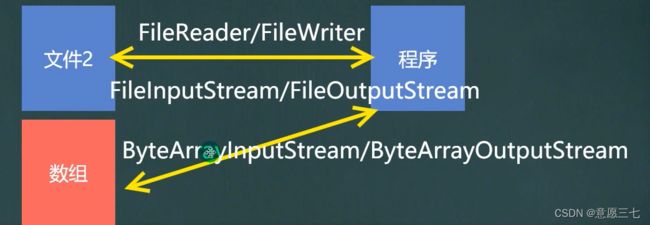
但是我们现在想让文件操作功能变得强大一点就使用包装流类,也就是上面说的处理流,可以即对文件类型操作,也可以对数组源来操作, 我们使用BufferedReader 和 BufferedWriter
那么为什么他们可以这么灵活呢,我们去看看源码
BufferedReader 的源码里面就有个属性Reader, 这个Reader的子类有那些节点流子类,那么就说我们以后可以直接使用Reader的任意子类。

BufferedWriter也是一样的,里面有个属性Writer

类图:Writer的子类
所以这就是BufferedReader 和 BufferedWriter的强大的地方
3.1节点流和处理流的区别和联系
节点流很底层的~~直接和数据打交道
3.2 处理流-BufferedReader 和 BufferedWriter
3.2.2 BufferedReader
操作案列~~
public static void main(String[] args) throws Exception {
//要操作的文件路径
String pathFile = "E:\\test\\j.txt";
//创建BuffeReader
BufferedReader bufferedReader = new BufferedReader(new FileReader(pathFile));
//读取
String line;
//按行读取,效率高
//1.bufferedReader.readLine() 按行读取 返回空 读取完毕
while((line = bufferedReader.readLine())!=null){
System.out.println(line);
}
//关闭流 只需要关闭外层流(BufferedReader) 会自己关闭FileReader的
bufferedReader.close();
}
我们来看看为什么直接关闭外层流,其实他底层是关闭的是那个参数的close();
3.2.3 BufferedWriter
public static void main(String[] args) throws IOException {
String filePath = "E:\\test\\a.txt";
//创建一个BufferedWriter
BufferedWriter bufferedWriter = new BufferedWriter(new FileWriter(filePath));
bufferedWriter.write("哈哈哈写进文件1");
bufferedWriter.newLine(); //插入一个和系统相关的换行符
bufferedWriter.write("哈哈哈写进文件2");
bufferedWriter.newLine(); //插入一个和系统相关的换行符
bufferedWriter.write("哈哈哈写进文件3");
//插入一个换行
//关闭外层流即可
bufferedWriter.close();
}
newLine() 插入一个和系统相关的换行符,没有这个不会换行
如果我们要追加,不可以到bufferedWriter加true,因为不支持
但是我们可以到
这个后面加true
3.2.4BufferedReader 和 BufferedWriter 完成文本拷贝
public static void main(String[] args) throws IOException {
String srcFilePath ="E:\\test\\j.txt";
String descFilePath = "E:\\test\\T2\\j1.txt";
String ScrLine ;
// 把源文件写到程序里面
BufferedReader bufferedReader = new BufferedReader(new FileReader(srcFilePath));
// 把程序的源文件写到硬盘中
BufferedWriter bufferedWriter = new BufferedWriter(new FileWriter(descFilePath));
while((ScrLine = bufferedReader.readLine())!= null){
//读取一行就写进去 没有带换行符
bufferedWriter .write(ScrLine);
//换行
bufferedWriter.newLine();
}
//关闭流
bufferedReader.close();
bufferedWriter.close();
}
这里建议try finally 这样保证关闭资源,不过我这里就简单搞搞,知道大概意思就可以了。
3.3 处理流-BufferedInputStream 和 BufferedOutputStream
看看BufferedInputStream 的类图:
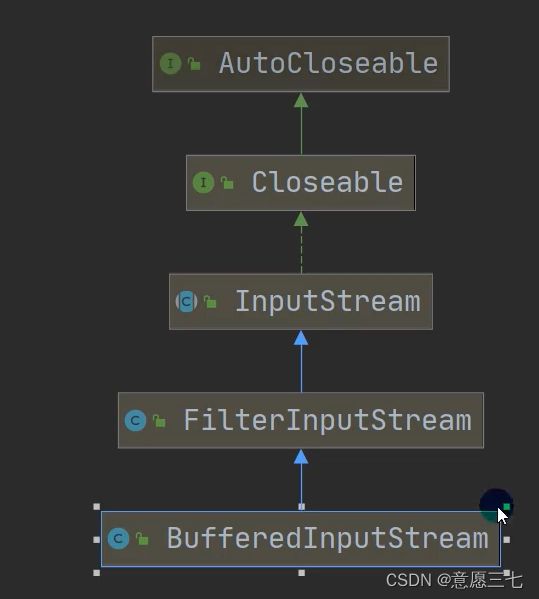
来看看他们的属性参数:
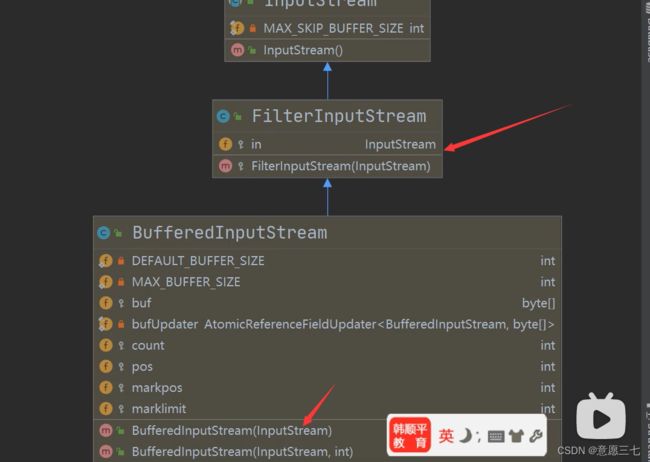
父类的属性in 类型是一个inputStream 那么就是说只要是inputStream的子类节点流都可以操作。
BufferedOutputStream
本类的buf是缓冲区 进行了优化,父类也有out 也是outPutStreamread 类型,子类的字节流操作都可以使用
3.3.4 使用BufferedInputStream 和 BufferedOutputStream拷贝文件
public static void main(String[] args) {
String srcFilePath = "E:\\test\\QQ1.jpg";
String DescFilePath = "E:\\test\\T2\\QQ2.jpg";
//创建BufferedInputStream和BufferedInputStream对象
BufferedInputStream bis = null;
BufferedOutputStream bos = null;
try {
//为什么使用这个 因为我们要操作的不是一个文本,
// 我们最好使用字节流来操作,无损,所以使用这个字节流,而且是InputStream的子类
bis = new BufferedInputStream(new FileInputStream(srcFilePath));
bos = new BufferedOutputStream(new FileOutputStream(DescFilePath));
//循环读取文件 ,并写入到DescFilePath
byte [] buf = new byte[1024];
int readlen =0;
//read() 没有文件返回-1
while((readlen = bis.read(buf))!= -1){
bos.write(buf,0,readlen); //写
}
} catch (IOException e) {
e.printStackTrace();
}
finally {
//关闭流
if (bis!=null){
try {
bis.close();
} catch (IOException e) {
e.printStackTrace();
}
}
if (bos!=null){
try {
bos.close();
} catch (IOException e) {
e.printStackTrace();
}
}
}
}
